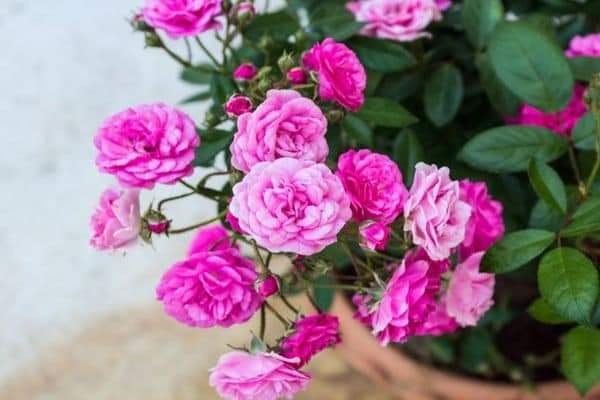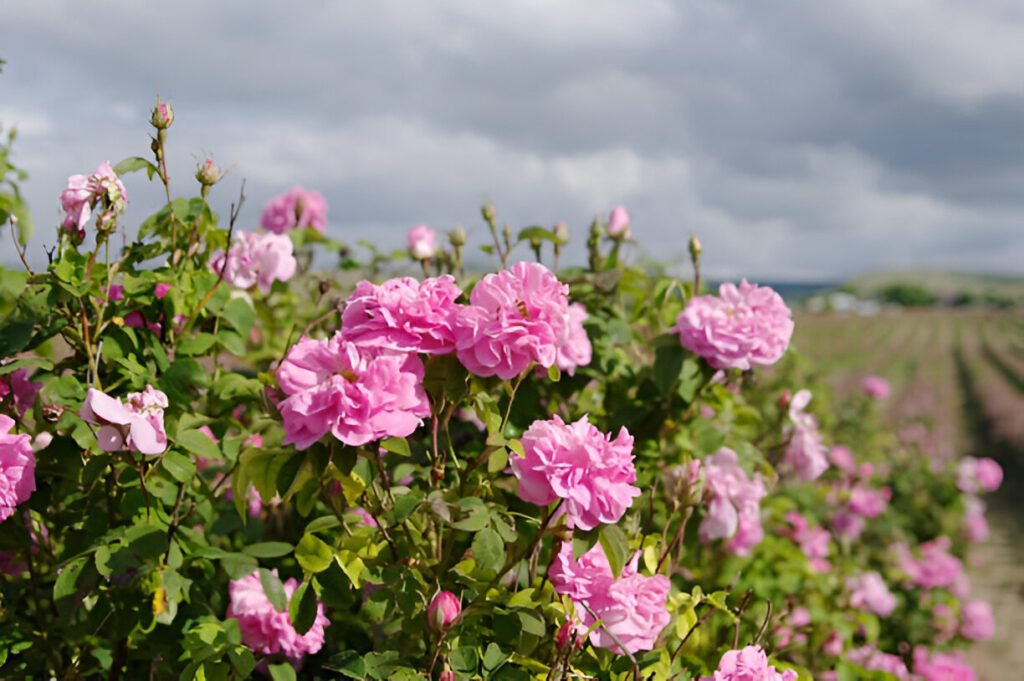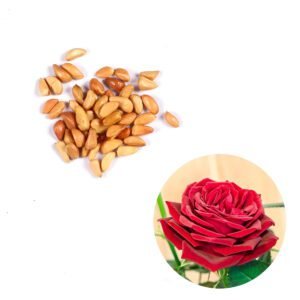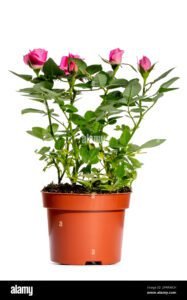Roses: definition, how to grow them, diseases, and caring for them
Introduction to roses
Vigorous deciduous shrub with arching, thorny stems bearing five- or seven-divided pinnate leaves, ovate to elliptic, serrated, grey-green leaflets and clusters of flat, semi-double, white or pink concave flowers.
Vigorous deciduous shrub with arching, thorny stems bearing five- or seven-divided pinnate leaves, ovate to elliptic, serrated, grey-green leaflets and clusters of flat, semi-double, white or pink concave flowers.
- Rosehip contains several components such as terpenes, glycosides, flavonoids, and anthocyanins that have beneficial effects on human health (analgesic, laxative, antidiabetic).

Basic care guide
- Amandi Butternut Flowers : They are often sweet-smelling, dark pink flowers, with central petals, and are a good disease-resistant plant.
- Arthur de Sansal flowers: Their flowers are often medium in size and have a distinctive scent. They are dark maroon red in color. They grow on short shrubs. Despite their beauty, their resistance to diseases is weak.
- Butzaris flowers are often white in color and have a pleasant smell. These flowers grow on medium-sized shrubs with dark green leaves. It is reported that the resistance of this type of flower to diseases is rather good.
- Original home
It originated from Damascus and was introduced to European countries.
- Nickname
Damask rose, Castile rose
- Platoon Rosaceae

The amount of water needed
- Prefers moist but not waterlogged conditions. When growing outdoors, it can be watered when the soil surface is slightly dry.
- In drought conditions, the plant needs water every 2-3 days.
- Winter is a dormant period, so it is okay to stop watering after that..
- Water the potted plant every two days during the growing season.
- It needs more watering from bud to flowering, and the amount and frequency of watering should be reduced after flowering
Suitable living conditions
Cold temperate to tropical regions. It likes cool, well-ventilated environments and does not tolerate high temperatures
- Temperatures
The optimum temperature is 15 to 26 degrees Celsius. Some species can withstand temperatures as low as -26°C and high temperatures as high as 35°C. When the temperature is below 4°C in winter and above 30°C in summer, the plant becomes semi-dormant and its growth is poor. The flowers during this period will have a few small white petals that are dull in colour, lustrous and not at all pretty in appearance.
Suitable lighting for him:
Rose plantings should be planted in full sunlight, away from trees or hedges so that the sun shines at least during the entire afternoon.
It tolerates a wide range of soil pH conditions from 6 to 8 and loamy loam to sandy loam soils.
-The soil must be free of weeds. Appropriate markings are placed on the ground at the optimal distance. A distance of 1.5 x 1.5 m2 is sufficient for optimal growth of plants.


Find out what light your plants are actually getting.
Find the best locations for them to improve their health, simply using your phone.
Fertilization care
Use fertilizer several times during the growing season, but only in small amounts each time.
– In the spring and summer, you can use liquid fertilizer twice a month.
- If you want to use rosehips for cut flowers, fertilize them 1-2 times a week during the flowering period.
How to plant seeds
- Rose seeds need a period of cold storage to germinate.
- 1- Place them in a seed tray, with saturated but not wet soil, cover them with plastic wrap, then place them in the refrigerator for 10-12 weeks.
- 2-Then remove it and place it in an area where the temperature is about 70-75 degrees.
-. 3 Fill the planting tray with suitable soil.
4-Put the rose seeds in the tray and cover them with about 1/2 inch of potting soil.
** Rose seeds should be planted in late winter, about six weeks before the last frost of the season.
5- Place the tray in a warm place that gets indirect light. It must be checked periodically. If the soil seems dry, remove the tray and sprinkle the soil lightly.
6–Pay attention to the emergence of seedlings and the growth of roots. This will take about 15 to 20 days.
Pruning
The main purposes of pruning are to train the plants to the desired shape, maintain the desired size, remove infected and diseased parts, remove terminal buds and change the growth habit to encourage denser roses, to provide more horizontal expansion and finally to produce more flower buds.
-Simple pruning (removing the final bud of vegetative shoots) or light pruning is sufficient in December and January.
During the second year, plants should be pruned twice a year, once in August when the plant is 50 cm high and again in November and December when the plant is 75 cm high.
Additional pruning should be done only once a year in the period from November to December at a plant height of one meter. Excessive growth of shoots must be checked, otherwise the size of the bushes will become unmanageable.
- Black spot: It affects the leaves through the appearance of circular black spots, leading to their eventual fall. It can be prevented by maintaining good water drainage and removing the affected leaves from the soil. The affected parts of the shrub must be removed, and the plant’s leaves must be kept dry by preventing Watering from above, especially after noon or evening.
- Powdery mildew: A grayish-white substance forms on the surface of leaves and buds, and may cause buds not to flower…. To treat this disease, watering the affected shrubs must be reduced, especially during times of heavy rainfall. The affected parts and all infected leaves on the ground near the plant must be removed. Fungicides can also be used.
- The plant is attacked by many insects, the most important of which are: aphids, which attack flowers and leaves, thrips, which attack flower petals and cause deformation, leaf miners (leaf miners)... An appropriate insecticide specific to the pest must be used.
If it is a houseplant, what are the best conditions for it to be cared for in a home?
- Commit to watering fixed periods of time based on the area in which you live
- Fertilize the soil, especially at the beginning of its growth period, making sure not to overuse fertilizers
- Pruning roses to maintain their shape and health and prevent them from being exposed to any forms of rot
- Use insecticides from time to time to get rid of harmful insects

Suggested use
- The flowers are harvested for their wonderful scent, and are harvested commercially for rose oil used in perfumery and to make rose water.
- The flower petals are also sometimes used directly to flavor food or to make tea and are considered safe for human consumption
- Roses can be used in baskets, gift boxes or vases for decoration, they are the best choice for engagement, wedding, Valentine's Day and anniversary.
- In hedge rows to help protect flowers from wind damage
Suitable planting time
Roses are often planted specifically during the winter season. In the months of January and February.
additional information
- Plant age:
Its life span is up to 50 years, and its economic life is about 25 years. The gestation period is three years to reach the economic production level
Plant height
Up to 2.2 m (7 ft 3 in) long
- Flowering stage
. The total flowering period is about 25-35 days but the bulk of the crop (about 75%) is obtained within 15 days of the peak flowering period.



